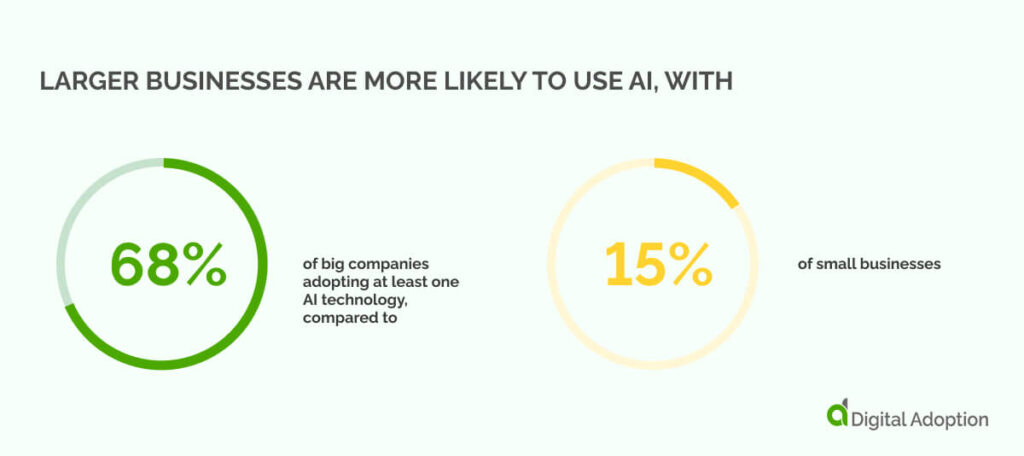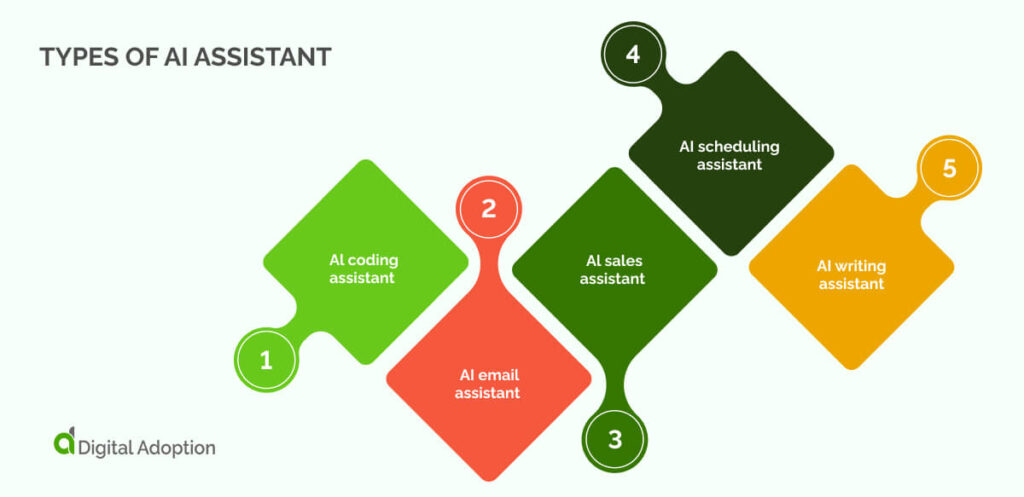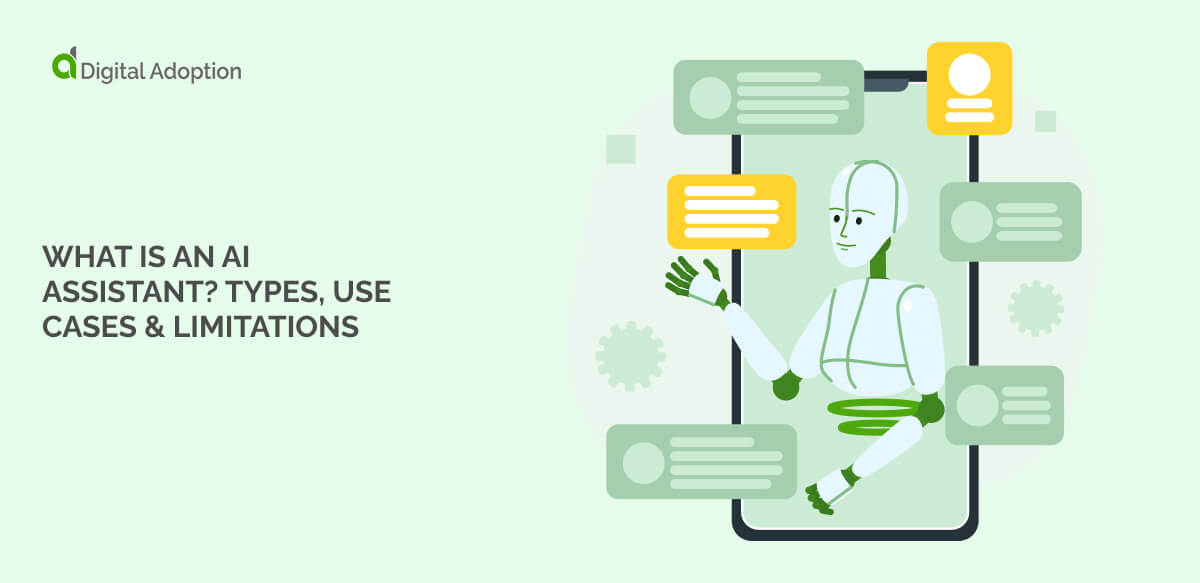With a growing number of artificial intelligence (AI) assistants entering the market, businesses face the challenge of choosing the right one to fit their needs.

As AI productivity tools become more sophisticated, selecting the best fit directly impacts efficiency, customer experience, and long-term success.
The rapid pace of development means that businesses must take a proactive approach to AI adoption. Waiting too long or embracing the wrong solution can lead to missed opportunities.
This article breaks down five key types of AI assistants, offering a closer look at how each can address specific business needs. We’ll also look at how AI assistants work, their use in different industries, and their limitations.
What is an AI assistant?
An AI assistant is a software tool that uses artificial intelligence to perform tasks, answer questions, and assist with decision-making to improve efficiency and productivity.
AI assistants augment human-led tasks and enhance knowledge sharing and decision-making through AI software.
These solutions use common AI technologies such as natural language processing (NLP), natural language understanding (NLU), and large language models (LLMs). They empower AI assistants to understand, interpret, and respond to user language in a human-like way.
Also known as AI virtual assistants or enterprise chatbots, AI assistants are a significant step up from traditional chatbots. Early solutions’ rule-based capabilities meant system responses were rigid and pre-defined.
These followed static A to B processes using simple query-mapping and pattern-matching methods. While impressive in 2002, chatbots have evolved into sophisticated conversational agents.
Today, AI assistants can aggregate customer and business data in real-time, enabling timely access to an organization’s historical knowledge. They can learn from past text and voice examples to deliver natural interactions, provide accurate information, and complete enterprise-level actions.
How does an AI assistant work?
To understand how AI assistants work, we must examine the core technologies supporting these solutions.
Decade-long advances in these fields have combined to create high-performing AI assistants capable of meeting today’s business demands.
Let’s take a peek into the core technologies underpinning AI assistants:
- Speech-to-Text (STT) & Text-to-Speech (TTS): AI assistants use STT to turn spoken words into text. Acoustic models analyze sound patterns, while language models predict words. TTS converts text into speech using synthetic voices. Neural vocoders make the tone sound natural.
- Machine learning (ML): Machine learning helps AI assistants learn from data. Supervised learning improves responses with labeled examples. Reinforcement learning fine-tunes accuracy through feedback. These methods allow assistants to handle tasks better over time.
- Natural language processing (NLP): NLP helps AI assistants understand human language. Parsing breaks sentences into parts, and semantic analysis finds meaning. Models like GPT and Google Gemini are good NLP-enabled examples that help improve the flow of conversations.
- Deep learning (DL): Deep learning uses neural networks to handle complex data. It processes text, images, and speech to perform advanced tasks. For AI assistants, this allows for managing long conversations and recognizing context.
- Generative adversarial networks (GANs): GANs create realistic outputs like voices or images. They combine synthetic data and real-world checks to improve quality. AI assistants use GANs for tasks like voice imitation.
Types of AI assistant

Now we understand what AI assistants are and how they work, let’s explore the most popular types on the market today.
From automating coding errors to identifying and qualifying sales leads, AI’s productivity gains have benefitted every industry.
Let’s take a closer look:
Al coding assistant
Enterprise technology is arguably the lifeblood of critical business operations. Gartner says that In 2023, only 10% of enterprise software engineers relied on AI coding assistants. By 2028, this figure is expected to grow to 75%.
Software disruptions or downtime can delay workflows and halt employee productivity. As such, CIOs are constantly tasked with ensuring the code supporting this software is reliable and up-to-date. This means reviewing redundant code, checking for bugs, deploying patches, etc.
AI coding assistants can now augment many of these human-led functions automatically. They can scan code for errors, propose optimizations, and even help developers write new code.
The added support of AI gives developers more efficient and accurate control over a system’s inner workings.
AI email assistant
Email has long been the main form of organizational communication and collaboration for decades. It enables essential correspondence and knowledge sharing between teams, departments, and B2C and B2B companies.
Often, email is the only touchpoint connecting businesses with their customers. Manual processes that require sifting and managing countless emails are the primary way to keep these channels optimized.
Now, AI email assistants can take over and fast-track communication strategies. The AI email assistant market size was valued at USD 0.71 billion in 2022. This reflects a growing demand for smarter, more efficient solutions that streamline email management and automate responses.
AI email assistants can process and organize incoming emails, sorting them based on urgency, sender, or content. They can automatically draft responses using pre-set templates or based on the context of the email.
These assistants also manage follow-up reminders, ensuring no email goes unanswered. These solutions can also schedule emails for optimal times, track open and click-through rates, and perform sentiment analysis on responses.
Al sales assistant
Sales teams are responsible for sorting emails, organizing customer data, and devising new sales strategies. These tasks are performed manually, which takes up a large percentage of their time.
Sales teams also have to manage all aspects of customer relationships, conduct market research, and source new marketing channels. As you may have guessed, AI can now perform many of these actions autonomously.
AI sales assistants can glean sales performance data to help teams understand how products and services are being received. This data can be used to predict future demands and potential customer pain points, allowing teams to readjust strategies.
The AI sales assistant software market is projected to grow from $1.61 billion in 2023 to $10.5 billion by 2032. This surge highlights the growing reliance on AI to streamline workflows and enhance customer interactions.
AI sales assistants can monitor customer interactions, assessing reviews, emails, and buying behaviors. This lets sales teams understand customer preferences and thus deliver more targeted experiences.
AI scheduling assistant
Time is money. As such, good scheduling is the quickest way to get a return on investment and make the most of your time.
Businesses follow schedules. This includes everything from workflows to people processes, software updates, and hardware upgrades. Historically, humans have cleverly configured these schedules. We have been responsible for balancing organizational timing across people, operations, and resource deployment.
They’d leverage manual systems like spreadsheets, Gantt charts, and basic scheduling software. These tools supported detailed planning but required human oversight to mitigate conflicts or disruptions.
Now, AI scheduling assistants can accelerate the delivery of scheduling needs. These solutions can coordinate meetings across different time zones and ensure schedules stay conflict-free.
The AI scheduling assistants market is expected to grow from $2.22 billion in 2023 to $17.26 billion by 2032, with a yearly growth rate of 25.6%. This growth reflects the rising demand for intelligent tools that optimize time management and reduce human error.
These assistants automatically update calendars with changes, set recurring events, and send reminders for deadlines or meetings. This keeps employees organized and reduces the risk of missed commitments.
AI writing assistant
The debate on AI’s future impacts on the creative industry continues to intensify, and the world of writing is no exception.
This is made possible using NLP, NLU, and LLMs, which AI writing assistants leverage to generate text-based outputs.
While AI cannot replace intrinsic writing talent, it is a valuable tool for enhancing specific writing tasks.
Cloud-based AI writing assistants made up over 75% of the market in 2023 and are expected to exceed $9.5 billion by 2032. This growth highlights the increasing reliance on AI tools to streamline content creation and improve efficiency.
AI writing assistants like ChatGPT have significantly impacted business and the social zeitgeist. Users across domains and industries can now enhance social media posts, marketing copy, product descriptions, and story-driven narratives.
For example, AI writing assistants can brainstorm ideas, improve tone and clarity in communications, and automate repetitive writing tasks. They can be used industry-wide, from e-commerce and advertising to education and creative arts.
How are AI assistants used in different industries?
AI’s capabilities can be valuable for several uses, with its impact being felt across various industries.
Here’s a look at how AI assistants are uniquely applied in different sectors:
Healthcare
AI assistants optimize administrative tasks in healthcare, from managing patient appointments to processing medical records. They help doctors diagnose faster by analyzing symptoms and providing recommendations. AI also monitors patients remotely, offering early alerts for potential health issues. These tools save time and improve patient care by reducing manual work.
Finance
The finance sector is being transformed by automating tasks such as customer support and fraud detection through AI assistants. They can analyze financial trends and assist with investment decisions. These tools help banks and firms offer personalized advice to clients. AI also helps reduce errors, ensuring better decision-making and risk management.
Education
AI assistants are personalizing the learning experience in schools and universities. They track student progress, suggest relevant resources, and provide instant feedback. Teachers use AI to identify students’ weaknesses and tailor lessons to their needs. These tools make education more efficient, allowing students to learn at their own pace while improving learning outcomes.
Life sciences
In life sciences, AI assistants help researchers analyze large data sets, identify patterns, and speed up drug development. They also assist with genetic research and clinical trials, offering more accurate results. AI tools also optimize the design of experiments, helping scientists make faster and more informed discoveries. This improves both research efficiency and healthcare solutions.
What are the limitations of AI assistants?
Now that you know how AI assistants are used across different industries, it’s time to learn about their limitations.
Understanding these challenges is important for making informed decisions about where and how to use AI effectively. It helps ensure that it complements human work rather than replacing it entirely.
Let’s take a closer look at the limitations of AI assistants:
- Lack of emotional intelligence: AI can’t understand feelings or emotions. It follows instructions but can’t comfort someone or deal with emotional situations like a person can. So, it’s not great when dealing with upset customers or personal problems that need care and empathy.
- Limited understanding: AI doesn’t always fully understand tricky or complex situations. It uses patterns in data but doesn’t have real “thoughts” like humans. They might make mistakes when things are unclear or need creativity.
- Dependence on data: AI needs lots of data to work well. If the data is incomplete, wrong, or biased, the AI’s answers can be poor. It depends entirely on the quality of the information it has, so if that’s off, it can make errors.
- Privacy and security concerns: AI assistants collect personal or business information. If not protected, this can cause privacy issues or lead to data being stolen. Poor security could allow hackers to access sensitive information, putting users at risk of identity theft or misuse.
Choosing the ideal AI assistant
AI assistants can make a big difference in many industries, but some prerequisites must be followed for them to work well.
Let’s take a closer look at how to choose the ideal AI assistant:
- Precision and consistency: AI must always give the same correct answers to build trust.
- Data privacy and protection: It’s important to keep information safe and follow the rules to protect people’s privacy.
- Task efficiency: AI should help save time and get things done faster.
- Ease of use: The AI must be simple for people to use, even if they’re not tech experts.
- Affordability and value: AI should be reasonably priced and worth the money it costs.
Choosing the right AI assistant is crucial for maximizing its impact. With the right tool, businesses can streamline tasks and improve decision-making. When selecting an AI assistant, it’s important to consider your specific needs, ensuring it aligns with IT operations and supports long-term success.
People Also Ask
-
Which is the best AI assistant?The best AI assistant depends on your needs. Popular choices include Google Assistant, Apple Siri, and Amazon Alexa. Each excels in different areas like smart home control, searching, or managing tasks, so the best one for you will depend on your preferences and ecosystem.
-
Is there a free AI personal assistant?Yes, there are free AI personal assistants like Google Assistant, Apple Siri, and Amazon Alexa. They are available on smartphones, tablets, and other devices, offering basic tasks like setting reminders, answering questions, and controlling smart devices without any cost.









